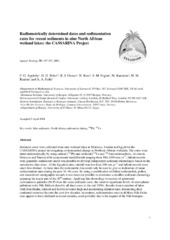Radiometrically determined dates and sedimentation rates for recent sediments in nine North African wetland lakes (the CASSARINA Project)
Appleby, P. G.; Birks, Hilary H.; Flower, Roger J.; Rose, Neil L.; Peglar, Sylvia M.; Ramdani, Mohammed; Kraïem, Mohammed M.; Fathi, Adel A.
Abstract
Sediment cores were collected from nine wetland lakes in Morocco, Tunisia and Egypt for the CASSARINA project investigating environmental change in Northern African wetlands. The cores were dated radiometrically by using natural (210Pb) and artificial (137Cs and 241Am) radionuclides. At sites in Morocco and Tunisia with mean annual rainfall totals ranging from 500–1000 mm yr−1, fallout records were generally satisfactory and it was possible to develop independent sediment chronologies based on the radiometric data alone. At the Egyptian sites, rainfall was less than 200 mm yr−1 and fallout records were much less distinct. At these sites the radiometric data could only be used to give an indication of mean sedimentation rates during the past 30–40 years. By using a combination of fallout radionuclide, pollen, and macrofossil stratigraphic records it was however possible to determine a credible sediment chronology spanning the major part of the 20th century. Applying this chronology to records of spheroidal carbonaceous particles (SCP) from the same sediment cores, the onset of significant levels of atmospheric pollution in the Nile Delta is dated in all three cores to the mid 1950s. Results from a number of lakes (Sidi Bou Rhaba, Ichkeul and Korba) revealed high and accelerating siltation rates, threatening their continued existence beyond the next few decades. In contrast, sedimentation rates at all three Nile Delta sites appear to have declined in recent decades, most probably due to the impact of the Nile barrages.
